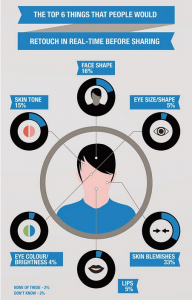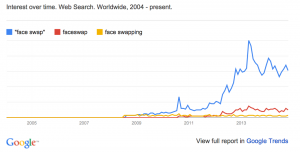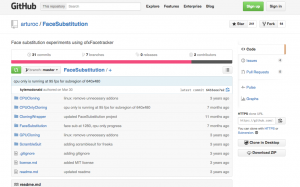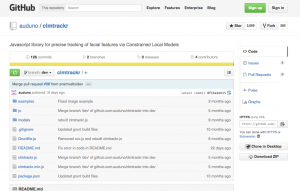With the world now being fascinated selfies as a form of self empowerment… and alternatively, in personal transformation, mutability of identity, role playing and masquerade on the internet, I present to you: Swappies (term coined by Randall Packer – Oct, 2014); a Repository. Swappies are essentially FaceSwaps a photoshop technique that involves digitally swapping the faces of two or more subjects depicted in a given photograph. With a swoppie, a person is deprived of the control posting a selfie would give. In fact, it gives zero control to what they would look like. In an infographic created by MediaBistro, it shows the top 6 things that people would retouch in their selfies before sharing them online; these are the factors posting a selfie can control as opposed to a swappie.
According to Dr Rutledge, we enjoy opportunities to experiment with different identities – and the selfie allows just that. “We all want to be able to ‘try’ on a new image and imagine how we would feel as that part of ourselves,” she explains. The exact origin of face swapping is unknown. Two of the earliest known exploitable photoshop memes in the early 2000s, Asian Prince and Little Fatty, featured many examples in which the subject’s face was superimposed over someone else’s.

On September 6th, 2004, the Internet humor site Something Awful posted a series of photoshopped images in which the faces of grandparents were swapped with babies they were holding.
On November 1st, 2009, the Nic Cage as Everyone single topic blog was created, featuring curated photos with the face of actor Nicolas Cage swapped in. 
These images got people talking and caused a spike and increase in people searching for and talking about face swaps:
As seen on the graph above, the peak of interest was in 2013 and the topic has since seen a decline in interaction. What i hope to do with my project is to make people react to swoppies. Seeing the above images, even though we don’t know and do not have any personal relations with the people pictured, we still react to a faceswapped image; we may find it funny, we may find it weird; whatever – as long as there IS a reaction.

(my current tumblr site with reblogged images of swoppies floating around in tumblr) My project hopes to create a repository and database of swopped images. I would source images from social networking sites that are marked public and create a swappie out of their images. I would then invite them to have a look at the byproduct on my site. They can also choose to share these images on social networking sites such as facebook, twitter and flickr and also tag and comment on them. I’m also contemplating on creating a widget that would encourage people to create their own swoppies by activating their webcam using open-source javascript. (similar to CLMtrackr by Audun Øygard) I’ve found a GitHub repository with open-source codes: in relation to Face Substitution.
Finding these open source files are the first step, next would be appropriating it – which i’m afraid I would run into problems with because i’ve never done any coding or programming before and they all look like they’re written in a foreign language. :/
However, in any case that programming doesn’t work out, I’d still think my project would be a success if my swoppies manage to grab the attention of viewers, get them to tag their friends, leave comments and share them with other people.







It’s always good to have a Plan B: I like the idea of providing open source software for viewers to create their own swappies, but perhaps that might be another phase of the project for a later point in time? For the time being, I like the idea of you swapping the swappies yourself (I think the “a” is a more accurate spelling…) and then providing a means for the swappies to go public or even viral via social media. The question is: will those who have been “swapped,” will they want their swappies to keep proliferating? What happens if someone is not satisfied with their swappie? Perhaps that brings us back to Plan A: maybe by generating a swappie you will create interest in the viewer to generate their own, so in fact they do have control. Let us know when your Tumblr feed has begun, it would be good to test out the process with our class.
PS: Don’t forget the featured image.